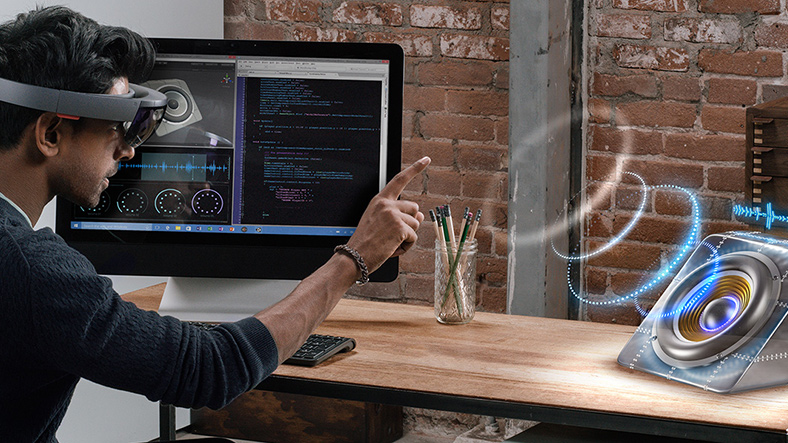How is Mixed Reality (MR) changing how we see the world?
2017, so far this year we have seen an array of technologies gain steam from Artificial Intelligence (AI) to Big Data and Augmented Reality (AR), these technologies will shape the future and change the way we see the world. In this post, however, the growing trend of Mixed Reality (MR) and its effect on our lives will be discussed.
Before diving in deep into the discussion, it is crucial to know: What is MR?
MR or Mixed Reality is sometimes referred to as hybrid reality, is the merging of real and virtual worlds to produce new environments and visualizations where physical and digital objects co-exist and interact in real time. Mixed reality takes place not only in the physical world or the virtual world, but is a mix of reality and virtual reality, encompassing both augmented reality and augmented virtuality via immersive technology. [Wikipedia] This technology is really new and still in development stages, and has garnered the likes of many.
That being said, companies such as Microsoft, Sony, Apple and HTC, the big players in the market, are creating MR headsets such as the Hololens (Image 1 below). But the real question to ask is that, do we need such technology? Is it any better than AR or VR? Is it really going to impact us in positive way and if so, then how?

Do we need such technology?
The answer to this question is not as simple as you may think. There are two ways to look at it. First, MR can really open up boundaries and possibilities in ways things are done. For example Gensler, a design company, used SketchUp Viewer on Microsoft HoloLens, a mixed-reality solution that allows users to virtually experience and inhabit holographic designs while being able to interact with the real world environment. This gives the designers an entire new way to visualize, tweak and digitize their creations. Currently, per say, designers use 3D printers to print their creations in order to get a better sense of design, but with MR they could just put on a headset and see the changes in real time in 3D holograms. Just imagine the possibilities. The other way to look at it would be that we already have AR and VR which can solve the same purpose in different ways.
MR a couple years from now?
I envision MR to be really a pioneer in many industries and household that will literally change the way we interact with our world. From visualizing 3D Models to immersive and interactive gaming. MR can really target all the markets. The technology is still too young to be of much real use for the daily business right now but it does have a tremendous future up ahead.
Refrences:
https://www.microsoft.com/en-us/hololens
Design revolution: Microsoft HoloLens and mixed reality are changing how architects see the world
5 comments on “How is Mixed Reality (MR) changing how we see the world?”
Comments are closed.


Hi Saran,
Great post about MR and the differences from VR and AR. Microsoft’s Build keynote had a demo with a French Theater company that was also using MR to speed up the design of their sets. One question that is interesting to me is whether MR will merge with VR and AR in the future. Facebook is of the opinion (from their F8 conference keynote) that VR and AR will merge as the technologies become more mature…
Users who have LIKED this comment:
Hey Gaurav,
Definitely! I do see AR and VR merging. Looking at the trends in these technologies the focus has slowly shifted from VR to AR and in the future it will be MR which would possibly combine the core principles of both. Until then the technology has to mature and then time will play its role…
Nice blog post!
I didn’t now that such technology was already in this stage.
I think that the way companies make their products prototypes will drastically change in the next few years.
The costs will be reduced, because they won’t need to produce a prototype every time. Additionally, there will be a huge amount of time saving.
Looking forward to read more news about MR technology.
Users who have LIKED this comment:
Hi there,
I really love the VR/AR/MR technologies, and had much fun reading this post and all the comments.
I am a structural engineering student, and was working on a building design with collaborators from different schools some time ago. Since we were spread across different time zones, we relied on VR during our meetings to walk through the designs and make improvements. One of the drawbacks were that we had to wait until the next meeting, make the adjustments and generate the VR to see if we actually liked those improvements. I can see MR being very useful in optimizing our work flow, as we would be able to make changes in real time and finalize our decisions right away.
Can’t wait until it happens,
Sara D.
Users who have LIKED this comment:
Interesting post Saran.
I am currently in a MR project in my university. As students we have to integrate Microsoft HoloLens in a given context. The real advantage of MR technologies is the possibility to interact with the real world and not being isolated, which is the case when using VR technologies like HTC Vive.
But as you mentioned the technology is not ready yet to be used in daily business. The device gets quite heavy over time and the view is quite limited.
These are my experience with MR so far and I am looking forward to see how companies can benefit from it in the future.
Users who have LIKED this comment: